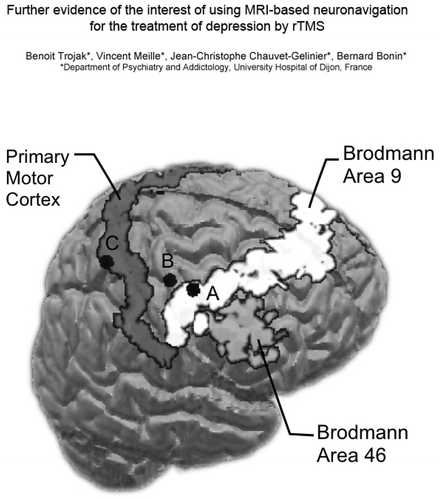Further Evidence of the Usefulness of MRI-Based Neuronavigation for the Treatment of Depression by rTMS
Case Report
A 50-year-old man, suffering from a major drug-resistant depressive episode that had evolved over 2 years in a context of unipolar depression, was referred to our department for rTMS therapy. For this patient, we decided to delivered 1-Hz rTMS sessions (360 pulses per session, 120% motor threshold) 1 week after all psychotropic drugs were stopped. MRI-based neuronavigation was used to localize the cortical site of stimulation (eXimia NBS Navigation System). We first used the “5-cm method” to target the DLPFC, which consists in localizing the motor cortical site that stimulates the abductor pollicis brevis muscle of the contralateral hand, and then measuring 5 cm anteriorly along the scalp surface in order to target the DLPFC.3 However, in our patient, as this method gave a cortical site outside BA 9 (in fact, in BA 8), the coil was moved to 6 cm anterior to the primary motor cortex in order to target BA 9 (figure 1). After the patient had received daily rTMS sessions from monday through friday for 6 weeks and then two rTMS sessions per week for 4 weeks, the Montgomery-Asberg Depression Rating Scale and the Hamilton Rating Scale for Depression scores, initially evaluated at 32/60 and 23/63, dropped to 8/60 and 05/63.

[A] Cortical target 6 cm. anterior to motor cortex; [B] Cortical target defined by the “5-cm. method;” [C] Cortical site that stimulates the thumb.
Discussion
This case shows the importance of MRI-based neuronavigation to localize the DLPFC. First, MRI-based neuronavigation takes into account variations in individual brain anatomy and gives precise data which are not available with the “5-cm method.” In our patient, the “5-cm method” gave a target posterior to the DLPFC, as was the case in Herwig′s study, in which 15 of the 22 subjects studied had the target placed too far back to reach the DLPFC.4 Second, using MRI-based neuronavigation, various areas of DLPFC subregions such as BA 9 and BA 46 can be easily individualized. The choice to stimulate either area can increase the efficacy of the rTMS therapy. As in our case, targeting the BA with MRI-based neuronavigation can lead to clinical remission of drug-resistant depressive episodes. Thus, BA 9 appears to be a promising area to target in rTMS therapy.
1. : Repetitive transcranial magnetic stimulation for major depressive disorder: a review. Can J Psychiatry 2008; 53:555–566Crossref, Medline, Google Scholar
2. : Analysis of functional neuroimaging studies of dorsolateral prefrontal cortical activity in depression. Psychiatry Res 2006; 148:33–45Crossref, Medline, Google Scholar
3. : A randomized trial of rTMS targeted with MRI-based neuro-navigation in treatment-resistant depression. Neuropsychopharmacology 2009; 34:1255–1262Crossref, Medline, Google Scholar
4. : Transcranial magnetic stimulation in therapy studies: examination of the reliability of “standard” coil positioning by neuronavigation. Biol Psychiatry 2001; 50:58–61Crossref, Medline, Google Scholar



